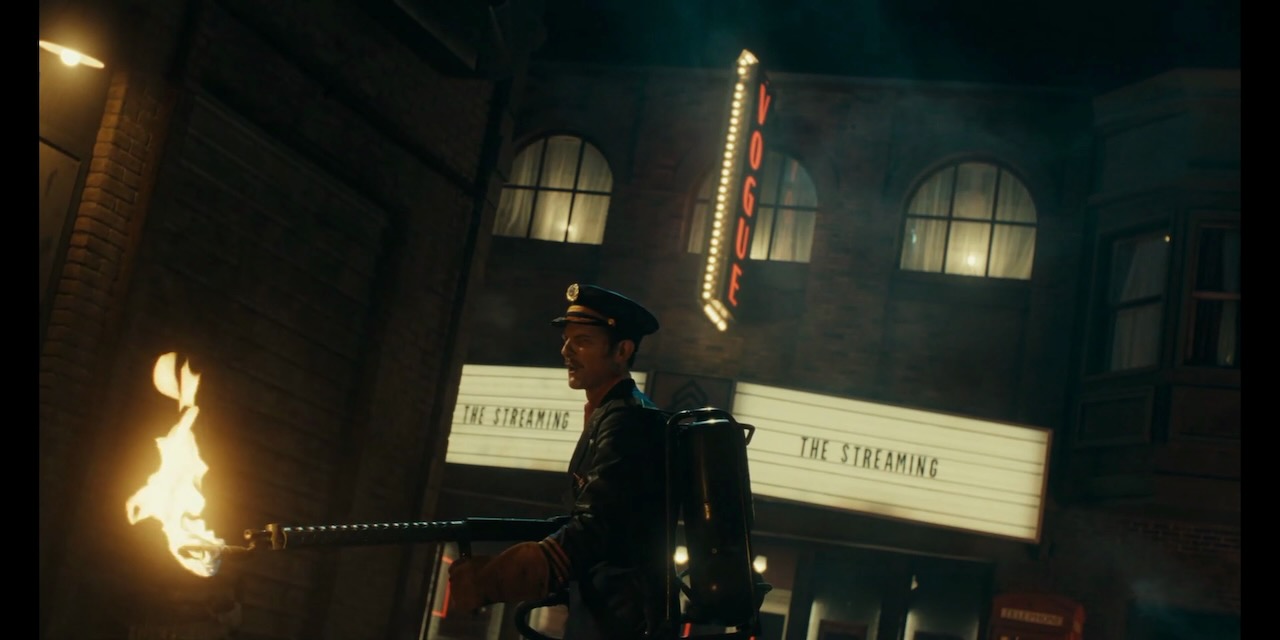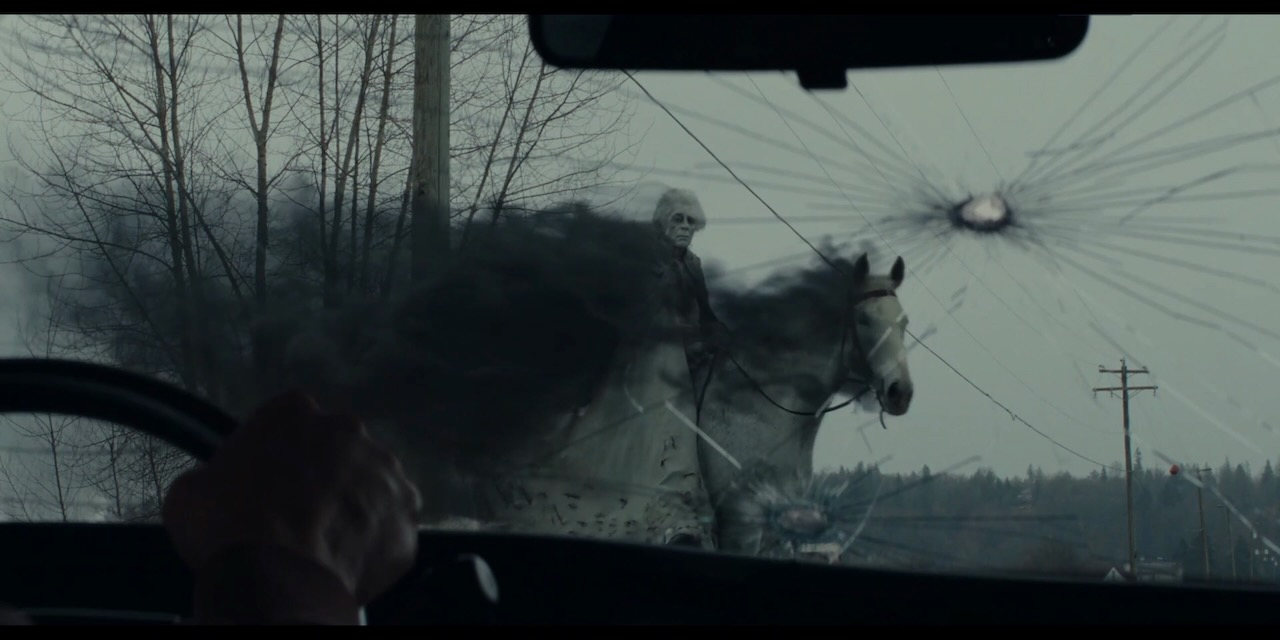I blocked off late January for Rotterdance, and premiere screening Asako was fantastic, then Belmonte and Rojo were pretty whatever… so I’m looking at the remaining options for the following week… Monos, Happy as Lazzaro… movies I keep hearing are great but don’t look attractive like Private Life and The Souvenir… mass-murder fashion-thing Vox Lux… serious stuff by Loznitsa and Petra Costa… and La Flor is there on the list, the ridiculous outlier which obviously I’m not gonna watch because there isn’t time. So that’s what I watched.
Movie from Argentina, in multiple episodes, with multiple chapters, the whole thing cut into multiple parts which don’t align with the episodes (but do align with the chapters) – it’s complicated. The director helps lighten things up by introducing the project in a prologue, looking into camera without moving his mouth, narrating in voiceover, and drawing his diagram of the film’s structure which landed on the cover of Cinema Scope.
–
Episode 1
Proper b-movie length at 80 minutes, and shot on low-grade video. The audio sounds dry and dubbed, but looks to be in sync. Scientists receive shipment of an ancient mummy, have to babysit it after hours, but one girl (and a black cat) get mummy-cursed, so a psycho-transference specialist comes to help. “I’ll tell you more about it,” she says, as the movie suddenly cuts to episode 2. A Mac OS 9 skype window proves this movie has been in the works for a long time.
Elisa Carricajo = Marcela, lead scientist who is introduced on an awkward date before hectic work day
Laura Paredes = cool, efficient doctor Lucia
Valeria Correa = dazed, cursed, water-guzzling Yani
Pilar Gamboa = mummy-curse specialist Daniela
Dr. Elisa, Dr. Laura:

Mummy-whisperer Pilar:

–
Episode 2
Famous singer Victoria reminisces to her hair-streaked assistant Flavia about Vic’s rocky/successful recording career and personal life with lousy singer Ricky. Out of the blue, Flavia is in a scorpion cult with the secret of eternal youth, but cult leader Elisa Carricajo doesn’t seem to trust her. Andrea “Superbangs” Nigro, a rival singer, has a whole speech about storytelling and protagonists (it’s a monologue-heavy episode) and is present in the recording booth during the very good climactic Victoria song (but why? I spaced out for a while).
Singer Victoria = Pilar = mummy-curse specialist Daniela
Assistant/Confidante/Cultist Flavia = Laura = cool doctor Lucia
Superbangs singer Andrea Nigro = Valeria = cursed Yani
Scorpion cult leader = Elisa = lead scientist Marcela
Nigro:

–
Episode 3
Epic spy drama that starts out fun, tries to pivot to being mournful as everyone appears to be doomed, and takes long sidetracks into backstory. The four lead women are teammates in this one – briefly they were five, until their leader Agent 50 takes out the mole sent by a rival assassin collective led by “Mother.” Both team leaders report to Casterman, a spymaster ordered to kill off his own people. It’s like pulp Oliveira at times – it’s never comedy, but has a delightful heightened quality to it. Multiple narrators of different sexes with different viewpoints, and at one point (not even at an intermission), Llinás stops the episode to show off his storyboards.
Casterman:

Commie-trained mute spy Theresa = Pilar
La Niña, daughter of a legendary soldier = Valeria
La 301, globetrotting assassin = Laura
Agent 50, Ukranian super-spy = Elisa
The promo shot… from L-R: 50, 301, Niña, Dreyfuss, Theresa:

My favorite scene, kidnapped Dreyfuss in the cosmos:

–
Episode 4
After all that narrative drama, this episode is aggressively messing with us. The actresses play “the actresses,” undistinguished and ignored. Llinás introduces them to new producer Violeta in a studio scene of choreographed arguments, then he ditches his production, taking a mobile crew to film trees in bloom with relaxing string music, stopping frequently to write in his notebook. I think it’s a parody of the pretentious filmmaker who has lost his focus/inspiration.


Halfway through, the focus changes, as paranormal investigator Gatto arrives at the site of a mysterious incident, finding the filmmakers’ car high in a tree, the camera and sound crew raving mad, and Llinás missing, having left behind his journals. Gatto calls the La Flor script notes “a load of crap,” gets mixed up with some residents of a psychiatric colony, and follows the director’s tracks through a series of used book stores, as Llinás searches for an old copy of Casanova with a deleted chapter. This all sounds like nonsense, but it comes together beautifully by the end, after seeming like a waste of time for a good while.
“He never refers to any of them in particular, as if the four were a single thing:”

–
Episode 5
“In episode five, the girls don’t appear… at the time we thought it was interesting.” I think it’s the same Guy de Maupassant story that Jean Renoir filmed in the 1930’s. A couple of cool dudes with fake mustaches give horse rides to a whitesuit man and his son, when they’re derailed by a couple of picnicking women, who pair off with the mustache men after whitesuit rides away. This is all capped with an air show, and is a lovely diversion after the long previous section.


–
Episode 6
Heavy organ music and intertitles – the four stars are reunited, but blurred as if shot from behind a dirty screen. Aha, it’s filmed using a camera obscura, a pre-camera device which throws a reverse image through a pinhole. Supposedly the women have escaped from unseen savages and are dodging a giant steampunk insect before returning to their homes. Partially nude and without closeups, they’re finally indistinguishable.

Essential reading: Nick Pinkerton for Reverse Shot and Jordan Cronk’s Cinema Scope feature.


































